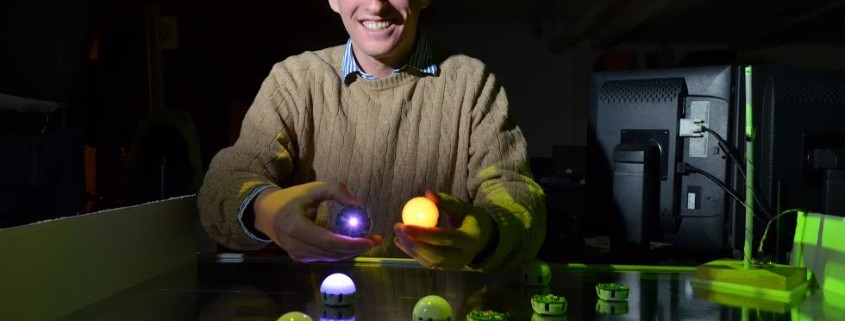Materials that Couple Sensing, Actuation, Computation, and Communication
The following Great Innovative Idea is from Nikolaus Correll, Assistant Professor in the Department of Computer Science at the University of Colorado at Boulder, about his paper with University of Colorado at Boulder doctoral student Andy McEvoy on Materials that couple sensing, actuation, computation, and communication.
The Innovative Idea
Advances in polymers and miniaturization of computing devices allow us to tightly integrate sensing, actuation, computation and communication into composite materials. Such “robotic materials” can sense their environment at high-bandwidth, implement high-speed feedback control to change their shape or appearance, and solve tough computing problems using distributed algorithms. Examples of such materials include a skin that triangulates and classifies textures rubbed against it, smart glass that can change its opacity and color, and that classifies letters drawn onto it, a beam that can change its shape, a dress that can localize sound, smart particles that allow to 3D print functional mechatronic objects, and large-scale art installations that use swarming to create the illusion of aliveness.
Impact
With computation shrinking at exponential pace and improving manufacturing techniques, we will be able to design smart composites that exhibit the camouflage abilities of the cuttlefish, provide load rebalancing like the banyan tree, change their shape like a bird wing, or provide high dynamic range, high bandwidth tactile sensing like the human skin. Lending autonomy to the systems they are integrated in, such smart composites can lead to robotic systems with the dexterity, agility, and smarts of a human, airplane wings that self-diagnose and adopt their aerodynamic profile to reduce noise and save fuel, or interactive buildings that conserve energy and allow users to customize their geometry and appearance.
Other Research
As such materials are not just incremental from the state of the art, but simply don’t exist yet, my group is bootstrapping robotic materials by addressing the problem from all angles: their design, their control, distributed algorithms that drive them, the applications they enable ranging from engineering to the arts, and their manufacturing. We seek answers to questions such as: how can we predict the resulting collective behavior given knowledge on individual interactions? How can we describe a desired global behavior using appropriate programming languages? What computational processes can be replaced with physical ones and vice versa? And, can we distribute extensive neural networks across the distributed computing architecture of a robotic material for pattern recognition and generation?
Researcher’s Background
I’m curious about the phenomenon of swarm intelligence. I’m interested in (1) what the underlying mechanisms of intriguing collective behaviors are and (2) how to leverage swarm intelligence for engineering autonomous systems. Starting my academic journey in swarm robotics and social insects, I realized that swarm intelligence is a scale-free phenomenon extending from molecules, cells, social insects, to the brain, and people. As such, improving our understanding in swarm intelligence might be key in creating systems that are truly autonomous.
Links
- Website http://correll.cs.colorado.edu
- Materials that couple sensing, actuation, computation, and communication https://www.youtube.com/watch?v=74cylf26xG8
- Teaching chemistry with Swarm robotics https://youtu.be/93TpgxWGvPc
- The Swarmwall, an interactive art installation https://youtu.be/ySkK9ngLVkg











